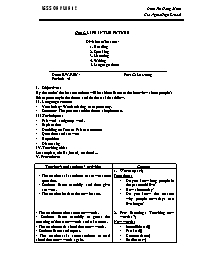Giáo án Tiếng Anh Lớp 12 - Unit 8: Life in the future - Period 46: Listening - Năm học 2014-2015 - Đinh Thị Hồng Minh

I. Objectives:
By the end of the lesson students will be able to listen to the interview about people’s life expectancy in the future and do the task that follow.
II. Language content
- Vocabulary: Words relating to expectancy.
- Structure: The present and the future simple tense.
III. Techniques:
- Pair work and group work.
- Explanation
- Deciding on True or False statements
- Questions and answers
- Repetition
- Discussing
IV. Teaching aids:
Lesson plan, chalks, board, textbook.
V. Procedure:
Bạn đang xem tài liệu "Giáo án Tiếng Anh Lớp 12 - Unit 8: Life in the future - Period 46: Listening - Năm học 2014-2015 - Đinh Thị Hồng Minh", để tải tài liệu gốc về máy bạn click vào nút DOWNLOAD ở trên
Unit 8: LIFE IN THE FUTURE Division of lessons: 1. Reading 2. Speaking 3. Listening 4. Writing 5. Language focus ___________________________________________________________ Date: 05/12/2014 Part C: Listening Period: 46 Objectives: By the end of the lesson students will be able to listen to the interview about people’s life expectancy in the future and do the task that follow. Language content Vocabulary: Words relating to expectancy. Structure: The present and the future simple tense. Techniques: Pair work and group work. Explanation Deciding on True or False statements Questions and answers Repetition Discussing Teaching aids: Lesson plan, chalks, board, textbook... V. Procedure: Teacher’s and students’ activities Content The teacher asks students to answer some question. Students listen carefully and then give answers. The teacher leads to the new lesson. - The teacher teaches some new words. - Students listen carefully to guess the meaning of these new words and take notes. - The teacher reads aloud these new words. - Students listen and repeat. - The teacher asks some students to read aloud these new words again. - Some students read aloud these words again. - The teacher listens and gives feedbacks. - The teacher asks students to find out the key words in these statements. - Students find out the key words. - The teacher lets students listen to the tape twice. - Students listen carefully. - The teacher asks students to discuss the answers with their partners. - Students discuss with their partners. - The teacher asks some students to give answers. - Some students give answers. - The teacher lets students listen again to check. - The teacher gives feedbacks. - The teacher asks students to find out the key words in these questions. - Students find out the key words. - The teacher lets students listen to the tape twice. - Students listen carefully. - The teacher asks students to discuss the answers with their partners. - Students discuss with their partners. - The teacher asks some students to give answers. - Some students give answers. - The teacher lets students listen again to check. - The teacher gives feedbacks. - The teacher raises the question. - Students discuss the question with their partners. - The teacher tells the homework. - Students listen and take notes. Warm up: (5) Questions: Do you know long people in the past could live? How about today? Do you know the reasons why people nowadays can live longer? Pre- listening: Teaching new words (7) New words: Incredible (adj) Fatal (adj) Centenarian (n) Eradicate (v) Life expectancy (n) Eternal (adj) While- listening: Task 1: Decide whether the following statements are T or F (11) F F F T T Task 2: Listen again and answer the following questions(15’) Eating more healthily, cutting down on things like butter, alcohol and cigarettes. The development in medical science. AIDS will also be brought under control. We’ll have been able to bring AIDS under control. Post- listening: (6) Ask students to discuss the advantages and disadvantages of having a very long life. 5. Homework: (1) - Leaning all new words by heart - Preparing for the new lesson. VI. Comments:
Tài liệu đính kèm:
 giao_an_tieng_anh_lop_12_unit_8_life_in_the_future_period_46.docx
giao_an_tieng_anh_lop_12_unit_8_life_in_the_future_period_46.docx





